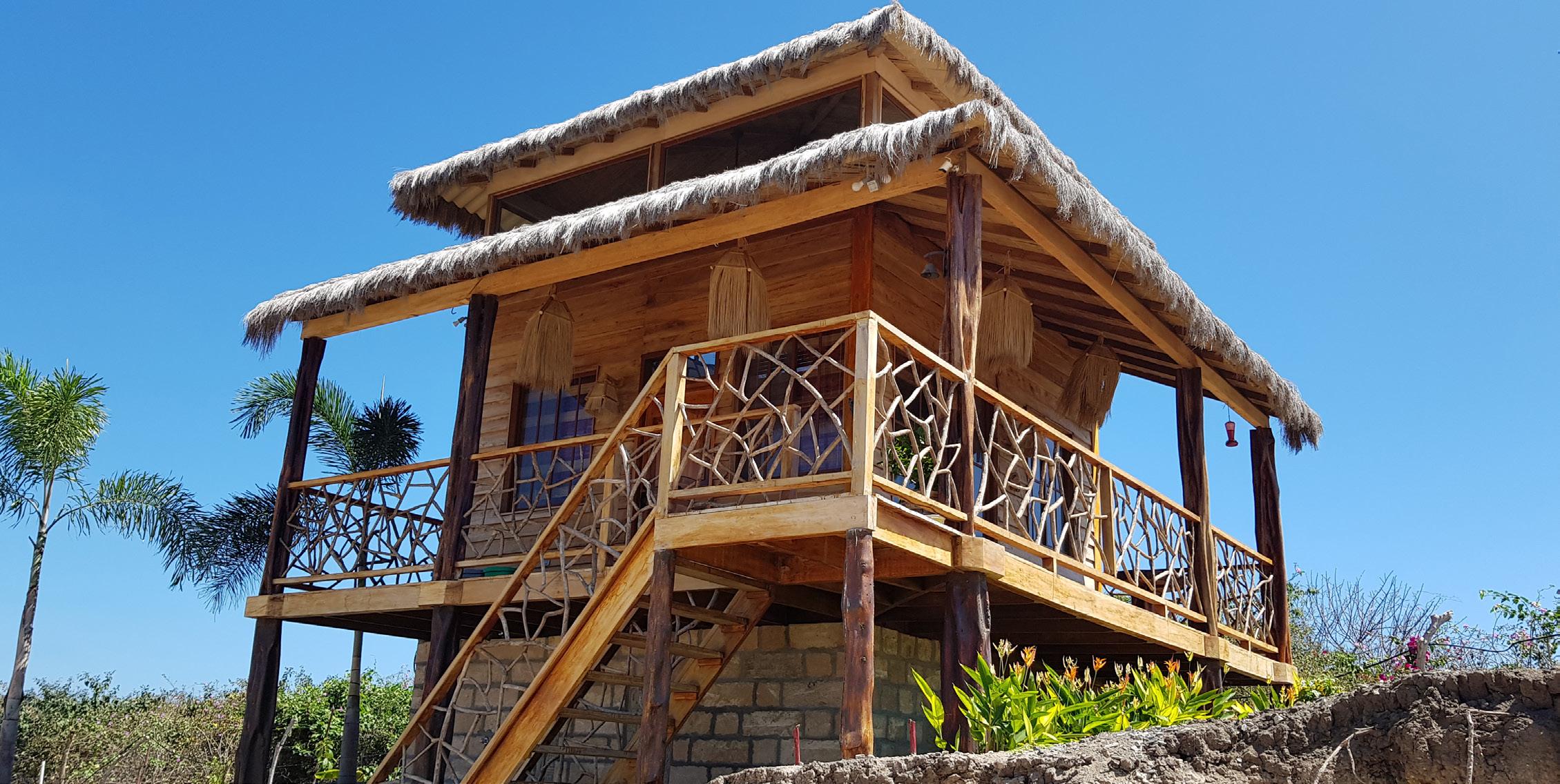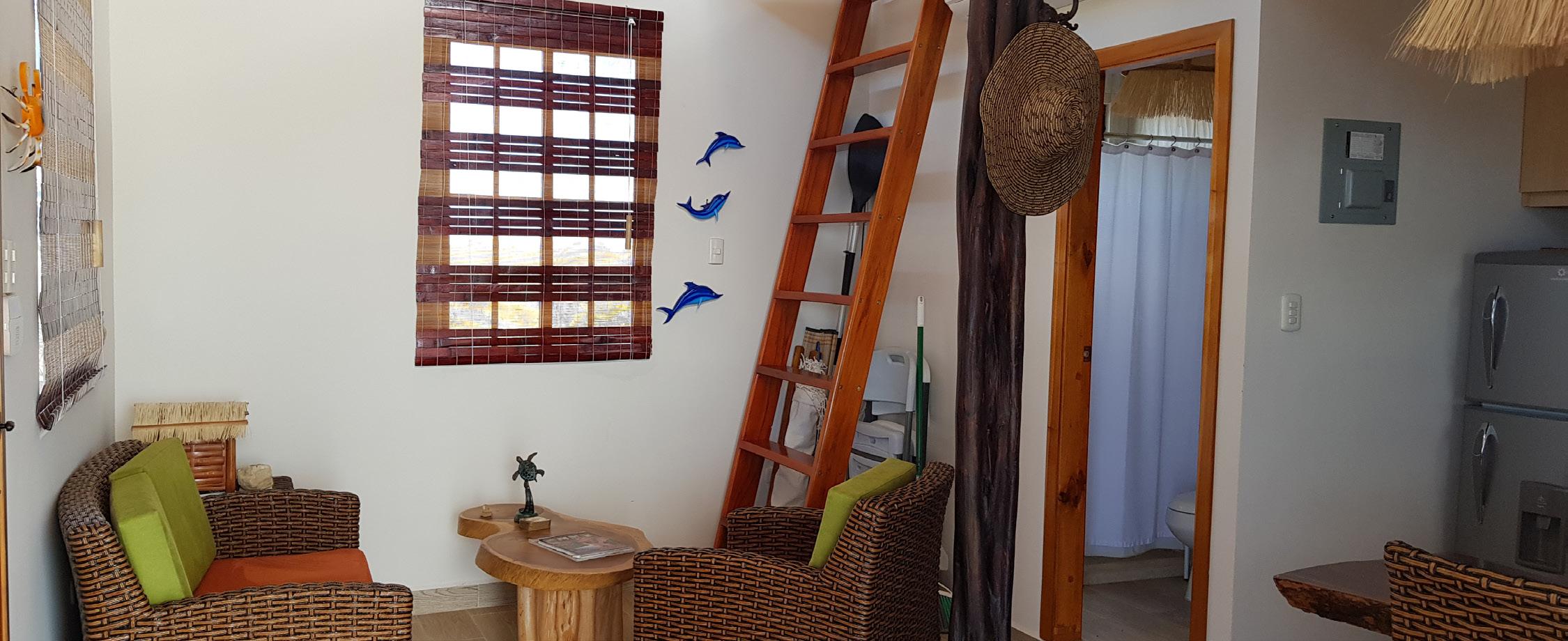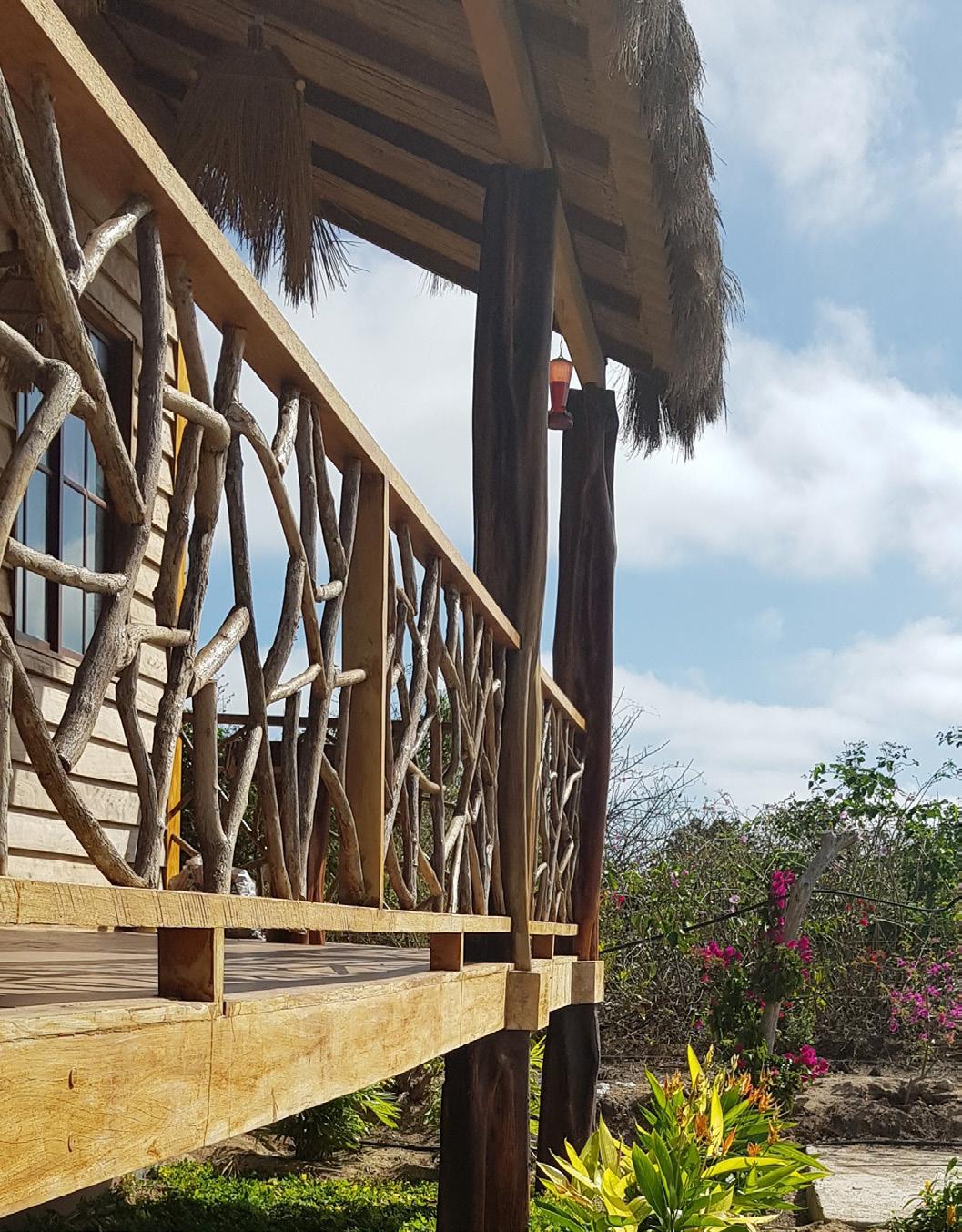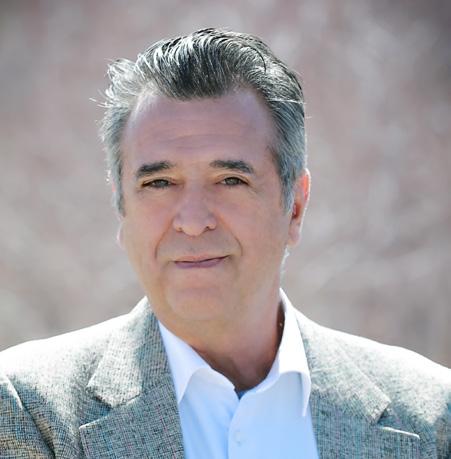
8 minute read
A Labor of Local Love
from AIBD magazine - Winter 2023
by AIBD
The Cisterna Cottage
By Fernando Pagés Ruiz
Advertisement
After three months of labor, we finally finished the Cisterna Cottage. So-called because it sits atop a 300-cubic meter potable water tank that will eventually quench seven homes on a point overlooking the Pacific Ocean.
Our little weekend getaway, perched upon the water tank, overlooks construction on a small development we’re building near Ayangue, a picturesque fishing village on Ecuador’s central coast. Right now, it’s just a lonely and quiet place to contemplate the sunset over whitecaps, but it will soon serve as an executive job shack for yours truly. After we finish a model home, the lovingly built cottage becomes a VRBO rental.
Because it’s the first building on site, and on weekends looky-loos come calling, the cottage had to set the bar for the rest of our project. Our development concept builds on blending the allure of aboriginal architecture with modern comforts. Thatched roofs, gnarly orange wood posts, webbed muyuyo railings, and tropical hardwood finishes with cold and hot running water, flush toilets, and even airconditioning (although you don’t need it).
Going, Native
To keep it real, we used local craft almost exclusively. Only two things in the cottage came from abroad, the ceiling fan, which I bought at Home Depot in Miami, and the first 50, A-35 framing clips. (Our carpenter had the remaining hundred or so wood connectors made by a local blacksmith, see Framing the Cisterna Cottage.)
Much of the material we installed was harvested locally by the same folks that did the work. For me, this was the most exciting part of the job, going deep into the rainforest on horseback, amidst towering bamboo groves, dense, tropical greenery, and the haunting cry of howler monkeys, to watch our machete-wielding workers cut the palm thatch that became our roofing, the brambles that became our railings, and the logs that became our posts. We chose the tree that became our kitchen countertop.
Our plumbing fixtures and appliances, while not of neighborhood manufacture, were made in Ecuador. The furnishings, chairs, bed, tables, and even our light fixtures were of local manufacture.
In future posts, I’ll take you to see how they harvest some of the building materials we used and how the word manufactured applies literally in this context, “manu” in manufactured means made by hand. Every board and nail in our little house has a local, human connection to the land and deeper meaning.
Part 1:
Local Lamps
When we built our beach house in the fishing village of Ayangue, we wanted to source every product possible from the local area and use local artisans to install it. Local sourcing was easier than I thought it would be. We had no other choice.

Among the many items locally sourced was lighting, made in the town of Libertador Bolivar, about ten minutes north of our cottage. Like so many villages in Ecuador, this one has a craft theme; in this case, it’s making lamps using strands of toquilla as shade.
We chose Anabel Floreano’s little shop, “Jelixa,” because Anabel made the lamps herself. At the same time, other street vendors sell lamps made by local craftsmen, the most famous of which is Anabel’s husband, Santo Reyes. Besides avoiding the middleman, we found Anabel and her children charming. We ordered the lamps we needed and paid for them in advance. We returned two weeks later to find her finishing our order, nimble fingers working palm fibers into the bamboo frame.
Paja Toquilla: From
Head Hats And House Lamps To Durable Roofing
In the USA, folks talk about living locally and buying locally-produced products. It’s difficult here because exports come cheap and local stuff can be more difficult to find than foreign-made. Not so in Ecuador, where high tariffs on imports and poverty conspire to create thriving local industries exploiting local products, such as the toquilla cane, a palm-like tree native to South America’s warmer climates, from which comes to a tough fiber used for hats, lamps, and roofing.
Anabel’s shaggy straw lamps have become one of the most striking features of our house. They sway gently in the breeze and provide a soft, warm light.
Organic Roofing
Of all things of straw, I was most curious about traditional roof thatch. Along the coastal area, there are two types: an actual palm straw called cade, made from the leaves of the tagua (Phytelephas) palm, or the so-called “elephant palm”
Above: Typical cade roof
because its seeds are hard like ivory. This cade or palmleaf straw material has a rustic, jungle-hut look, most often used because it’s cheap, although it lasts about five years before requiring replacement.

For our roof, we wanted the finer toquilla fibers (Carludovica palmata), from which they make Panama hats. I used to think toquilla fibers were just thin strands peeled off the same palm leaves as cade, but it turns out that toquilla fibers don’t come from leaves at all, and the plant they come from is not even a palm. It looks like one, but the toquilla plant has no trunk. It’s just leaves, sometimes three meters in length, that grow one from the other into something that looks like a fan. But it’s the stamen they use for the thatch and hats.
I wanted to see the whole process, so my contractor, Javier González, arranged for a visit to the pueblo of Dos Mangas, where I would meet a family that makes and installs toquilla roofing. It was a long ride along a dirt road to get to the family compound, where toquilla was drying on lines like clean laundry.
We paid Jose Suarez to take us into the forest and see from whence the toquilla comes. We saw the toquilla plants and learned about how the community stewards the forest, culling sustainably to keep the local crafts supplied with the raw materials of toquilla, cade, and graduate cane (bamboo) without depleting the forest. Mules carry the toquilla tubers down the mountain and into town; they require no human chaperone. They know the way.
The thin yet durable toquilla fibers that resist moisture and don’t break in high winds come from the fruit of this palmlike leafy plant. The fruit is a tuber, like a long, thin banana that grows from the center of a leafy spray. It’s called a cogullo.
The misconception that the toquilla comes from leaves is so common that locals poke fun at foreigners by plucking a large leaf off the plant to show its only practical application, making funny hats for foreigners.
As we ride through the rain forests near Manabi, Jose shows me different trees and what they’re good for, some for furniture, others for construction, and he invites me to smell the perfumed scent of trees. After so many years working with wood, I am only now appreciating where it all starts, in the forest.
It takes 12 of these cogullos to make one Panama Hat. The finest of these tubers go to hatmakers at a pretty price, but the seconds are used to make the durable and beautiful roofing material we came for.
Back at the family compound, we watched the process of making toquilla roofing. The first step in manufacturing, boil the tubers to soften the fibers. Then peal off the fibers – like string cheese – to fumigate the strands with sulfur, which explained the smell of the place. The sulfur smoke makes the fibers resistant to tropical pests. Next, they dry until dry enough for quick fingers to weave the fibers into toquilla shingles that provide shade and shelter from the tropical rain. In other words, a roof.
On the Job
Back at the beach house, the same family that harvests the toquilla and makes it into shingles would install it on our roof. The method is simple, layer upon layer, tied with toquilla string onto battens. Ecuadorians are highly tolerant of the occasional roof leak, considering it a minor inconvenience, if one at all. We’re not, so under the toquilla, you will see a standard, cheap, corrugated roofing called Eternit, made of cement fibers and asbestos – yes, also a local material.
This roof will last – they tell me – for about ten years before it requires replacement. Permanent roofs are also available in Ecuador, from zinc to clay tile, but none are as beautiful and fitting for a beach house as traditional tequilas.
Besides, it matches our lamps.
Part 2:
Building the Balcony
In equatorial warmth, folks, you don’t need a big house by the beach. We live outside. When walking any coastal town in warmer climates, you’ll see entire families on hammocks, sitting on sidewalk curbs and buckets, and balancing on rickety chairs with the television mounted on an exterior wall and fútbol game blaring. In constructing our little beach bungalow, the Cisterna Cottage, we plan to spend most of our time between the balcony and the beach.
Magic of Muyuyo
While my roofers worked and I looked on taking pictures, we talked about another local artisanship, the craft of building furniture, tools, and balustrades from the sturdy branches of the muyuyo shrub (Cordia lutea). It grows all over our property and would cover it if we didn’t continuously chop it down. When you live in the jungle, it’s constantly encroaching.
It turns out that the roofer’s son has his trade, and it’s building with muyuyo. I was happy when he offered to make our balcony railings – this would be the final touch of local craft. We harvested the muyuyo utilized on our land. I learned that the berries of this plant have a highly adhesive characteristic used as glue in traditional crafts. With stronger commercial adhesives available, the only modern application of the muyuyo berries is as natural (and free) hair gel.
I asked how long the harvested bramble would have to dry before we used it to build a balustrade but found curing had little meaning in a tropical setting where the humidity remained constant. One advantage of using local materials, they do not need to acclimatize.
So, with green, freshly cut bramble, the “moyuyeros,” or moyuyo carpenters, began piecing together our railings in much the way stone masons choose natural stones to fit into a wall, selecting the branch with the best fit. They used finish nails and wood glue to secure the boughs into an intricate and artistically sensitive web.
Our moyuyu railings turned out beautifully, and in the months that passed, I confirmed no shrinkage and a robust construction due to the wedging of the various branches. They decorated our cottage’s central post with liana, the swinging jungle vine of Tarzan fame, as a gift. All in all, these balusters and the vine remain my favorite element so our house.
Part 3:
Coral Stone
In most places, some local stone exists, and the province of Santa Elena, where our beach home awaits, was no exception. Throughout the province, you will find many walls of a tawny rock often called “coral stone.” It’s not; it’s sandstone, compressed for millions of years under the seabed. In some places, inland quarries exist, such as in the provincial capital city of Santa Elena. The comuna, or indigenous community coop, has a 50-year claim on the quarry to cut and sell the stone.
We bought all our stone there to make walls, the cottage foundation, and even to line the septic tank.
The operation is low-tech and somewhat brutal. Hugo Lopez Orrala chops chunks of rock off his sandstone claim using a wedge, sledgehammer, and muscle. Then his workers cut the stone into blocks of the size and shape required using circular saws with carbide blades. I described to Hugo the gas-powered, diamond-tipped concrete chainsaws available in the United States, and his eyes opened wide with tool lust. I would buy one and bring it to him. However, this tool puts Hugo at a decisive and unfair competitive advantage over fellow comuneros.
Fernando Pagés Ruiz
is a builder of affordable housing and developer of small communities. He is the author of Building an Affordable House and Affordable Remodel, published by The Taunton Press, and coauthor of Architectural Design for Traditional Neighborhoods with Korkut Onaran.











